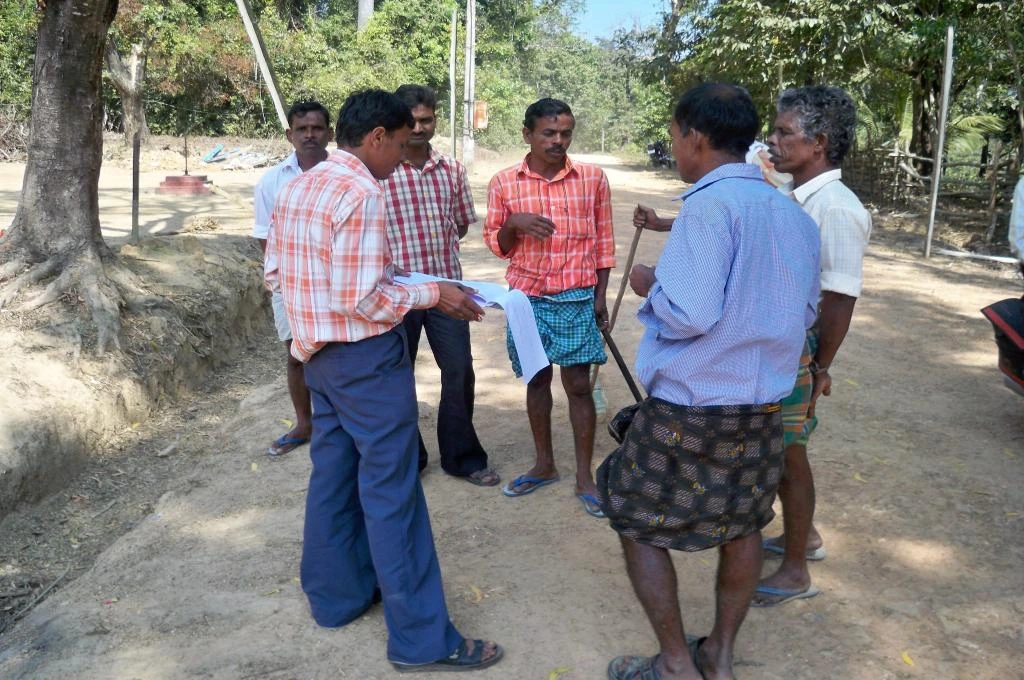As researchers dedicated to creating social impact, we strive to improve the lives of communities impacted by our work. However, the same communities are rarely included in our research processes beyond answering survey questions. Often, they are limited to being data sources, from whom we generate insights for policymakers to guide their programmatic decisions.
Thus, those most impacted by the policy decisions often have the least influence over them—they often are excluded from identifying problems/needs they care about most, interpreting data finds, and shaping recommendations. This approach not only overlooks the valuable locally contextualised knowledge they possess, but also fails to uphold the principles of dignity.
Participatory approach to research
A participatory approach to research empowers communities to actively participate in decisions that impact their lives. It recognises the importance of listening to the voices of communities regarding what evidence is needed and how it should be interpreted and used. Evidence is a valuable resource that should be accessible to communities and influenced by their perspectives, ultimately shaping policy decisions.

Recently, through Project Sampoorna in Jharkhand, India—(as part of the consortium, IDinsight is a monitoring and evaluation partner)—IDinsight used communication techniques and participatory methods like visual tools (storytelling boards and videos) to engage with school students and teachers—the primary respondents in the research. Through these tools, IDinsight shared some of the findings generated from the project’s baseline. This approach ensured participants’ inclusion in interpretation of data, thereby helping shape programmatic action based on their in-depth knowledge of school realities—this is a step toward more participatory research.
About the project
Project Sampoorna is a social-emotional learning (SEL) initiative led by the Government of Jharkhand in partnership with a consortium of non-profit organisations. At the request of our partners, we integrated a participatory lens in our evaluation efforts to ensure greater involvement of students and teachers.
Since the idea of using a participatory lens was explored after the implementation and evaluation designs were already finalised, the participatory elements were adapted accordingly and were focused mainly on sharing baseline findings.
We had collected baseline data primarily through student and teacher interviews and classroom observations. We wanted to share our learnings on student social-emotional skill levels, teacher behaviour, school climate, etc. to help teachers and students use this new evidence. We also wanted to get teachers’ and students’ input to contextualise our findings.
However, communicating complex survey findings with teachers and students, and ensuring their engagement, was fairly new to IDinsight—we typically share findings with policymakers and decision-makers but rarely with community members on the ground. We knew that sharing findings should not involve technical terms or a digital presentation; instead, we needed something simple, fun, inclusive and relatable. We worked with IDinsight’s Dignity and Lean Innovation teams to develop a plan and selected three school activities:

- Short video on baseline findings shared with teachers and parents on WhatsApp
- Storyboard presentation and ‘Draw Your Vision’ activity with students
- Discussion on baseline findings with teachers
In this blog, we share the team’s lessons from planning and executing a participatory approach to sharing our findings with students and teachers in government-run schools of Jharkhand.

Key Lessons learnt from participatory work in schools
Phase 1: Planning
Lesson 1: Evidence/data needs careful framing to ensure relevance, simplicity, and sensitivity
To engage stakeholders with our findings effectively, the careful selection and framing of the data were crucial.
For the video and storyboard presentation, we started by identifying the target audience and clearly defining key takeaways we wanted to communicate. We then shortlisted the most relevant and easy-to-understand findings to include.
For the discussion with teachers, we selected findings that, apart from being relevant and simple, were also those that we needed additional context on. We were mindful of sensitively framing the findings, especially those that highlighted improvement opportunities. Take a hypothetical example: If a finding states that “60% of teachers scold students for wrong answers,” we frame it as “most students feel cared for and heard by their teachers; however, data also shows that some teachers might scold students in the class.” In this way, we combine a negative finding with a positive one.
Input from teammates with experience in community engagement, including those outside of the project team, as well as our implementation partners who routinely work with these participants, played a valuable role in framing the findings. Additionally, we sought feedback from a group of teachers through a small pilot to ensure the findings were easy-to-understand, allowing the key takeaway to shine through.
Lesson 2: Visualising step-by-step execution of activities before school visits helps identify potential roadblocks and brainstorm solutions
To ensure smooth execution of our planned activities, we visualised the entire process from entering the school to conducting the activities to leaving the school. This helped us identify potential challenges, develop solutions, and gain more confidence.
We planned to conduct the storyboard presentation and drawing activity with students, and discussion with teachers in each school on a single day; hence, time optimisation was of utmost importance. To ensure efficient dissemination, we talked to school leaders, teachers, and implementing partners in advance. We clearly shared the goals of the school visits, communicated the logistical support needed, and confirmed teacher and student availability. This helped us reduce the time needed to initiate and organise the activities upon reaching the schools.

Phase 2: Execution
Lesson 3: Communication techniques should be familiar, inclusive and relatable to ensure audience engagement
To engage teachers and students with data effectively, we needed to use formats that resonated and had limited technical concepts. Our usual methods of sharing findings with clients would not have suited this context.
We therefore chose storytelling and activity-based techniques to communicate. For instance, the storyboard presentation and drawing activities we chose were part of the students’ day-to-day academic curriculum. The story we built was quite relatable because it included a teacher trying to improve her relationship with students and working with them to improve the class climate. Alongside verbal storytelling, we used a storyboard printed on a large flexible material stuck to the class blackboard—which, again, the students were used to looking at every day during class. The storyboard helped add to how relatable the story was—we used characters that looked like them, wore the same uniforms, and sat in similar classrooms. The drawing activity was a group activity; students enjoyed working with colours and collaborating on what they wanted to draw.
Since videos are always fun to watch, easy to understand, and shareable on social media, we developed an animated video for teachers and parents. When we showed this video to teachers, they found the story similar to what they had experienced in schools and were positive that both parents and other teachers would like and learn from it! Before starting the drawing activity, we also showed the video to the students, which inspired their drawing ideas.
Lesson 4: Using local and colloquial language by a familiar/relatable presenter helps the audience connect with the activities
To ensure relatability with the students, our team’s Field Manager took on the role of the storyteller for the storyboard presentation. It was important for the presenter to be someone the students could connect with in terms of language and cultural familiarity. We created a concise script in the local language with a colloquial touch, making it simple for students to understand.
As storytelling was a new format for IDinsight, we conducted multiple mock sessions with the team to refine the script and improve the tone and energy of delivery. Once finalised, our Field Manager diligently rehearsed the script with teammates and children in his community to improve its delivery.
While delivering the storyboard presentations in schools, we actively engaged the students by asking simple questions they answered in unison. This interactive approach helped maintain their attention and connection with the story.
Similarly, the video script went through several revisions with our video production agency to ensure the language avoided jargon and appeared friendly and relatable.
Lesson 5: Creating a comfortable and safe environment is necessary for good participation and candour
IDinsight’s interaction with students and teachers is typically limited to when we visit schools for data collection on our monitoring and evaluation work. This was the first time we visited schools to share our findings instead, and creating a comfortable environment for students was a top priority for their participation, enjoyment, and learning.
We collaborated with our implementation partners, who regularly engage with schools. Their presence helped us establish a rapport with school leaders, teachers, and students. Our partners facilitated introductions, conducted icebreaker games with students, and helped us communicate better with teachers and students.
We also actively participated in icebreakers, which helped students feel at ease with us. The “draw your vision” activity allowed quieter students to express themselves through art, ensuring inclusivity. We also emphasised that participation in the activities was voluntary and respected students’ choice not to participate.
With teachers, we initiated conversations with a round of introductions and discussing the subjects they teach. We empathised with their experiences and challenges, creating a comfortable space for them to share their thoughts and opinions openly.
Phase 3: Insights Generation
Lesson 6: Document participants’ insights and recommendations to inform programme design and implementation
Given our goal of seeking input on the baseline findings, our activities were specifically designed to generate valuable insights. We took diligent notes on teacher and student responses and observed their levels of engagement. While the input on findings from teachers was relatively straightforward, the feedback from students was particularly interesting.
This is because the latter was in the form of semi-structured discussions, and drawings we reviewed to derive meaningful insights. We shared these valuable insights with our partners to inform programme improvement efforts. For example, an artwork showcased classmates supporting a student with a physical disability and including him in their playground games. This vision could be used to build a student parliament-led project to ensure a disability-friendly school environment and infrastructure.
What’s next?
Our initial foray into participatory methods as part of the Sampoorna project has been a valuable learning experience. These insights will shape our future work and contribute to the broader landscape of similar projects at IDinsight. As we move forward, we are excited to refine our approach further, deepen our collaborative efforts, and continue making a positive impact in the communities we serve.
Acknowledgements
I would like to thank Sumedha Jalote, Neha Raykar, and Debendra Nag for their reviews and valuable input on this blog. Special thanks to Tom Wein for his guidance in shaping this work and encouraging thoughtful reflection and knowledge sharing.
This article was originally published on IDinsight.




